Coming Soon!!!
INTRODUCTION
This app has been developed as a guide for the identification of Australian bats, providing descriptive summaries and basic biological information, distributions, and echo-location call examples. It will be updated as new information comes to hand, and even at this point, we have two potentially new species to be added!
Much of the content is based on second edition of Sue Churchill’s ‘Australian Bats’ published in 2008. This in effect, is an updated digital version of the guide with new information added, new and authenticated images and also including a significant collaboration with Australasian Bat Society to provide the most up-to-date distribution maps that exist for Australian bats.
Taxonomy is based, in large part on the treatment provided in the ‘Handbook of the Mammals of the World’ – Volume 9, with minor changes and updates for a few species, but none of which break new ground!
We have also suggested a set of common names that are consistent with this publication, some of which depart from our generally accepted Australian standards. For example, Miniopterus are found throughout much of the World and are referred to elsewhere as ‘Long-fingered’ bats rather than as ‘Bentwing’ bats.
While these changes have been suggested, they are not obligatory and there are many different common names applied to species historically and regionally. Users are encouraged to make their own independent assessment and use names they feel are appropriate.
Although a somewhat tedious point to make – this publication is not “issued for the purposes of zoological nomenclature, and therefore is not published within the meaning of the Code” (Article 8.3 of the International Code of Zoological Nomenclature).
- Distribution maps have been provided courtesy of the Australasian Bat Society and are independently available via their website https://www.ausbats.org.au/batmap.html
There is also a contact address on that site if you want to suggest changes.
- We recommend that this app should not be used as a basis for the identification of bats, based on the echo-location calls presented in the species accounts. This is because the images are examples only, and don’t describe the variation that exists within populations or between different geographic areas.
- The species identification keys are rather technical, and most bats need to be in the hand to allow accurate identification. Even then many bats are difficult to identify and for this reason often quite arcane details (such as penis shape or ratios of wing bone lengths) need to be examined to tell them apart. The keys are interactive, and we recommend that you start with the top-most characters and work down the list. As each one is answered, it will disappear, and the number of taxa shown at the bottom of the screen will hopefully reduce until you have just one left. However, in some cases you may have more than one. In those cases, you may need to read the descriptions to arrive at an answer. At all stages in the keys, you can use distribution to narrow down the suspects (use the “Regions” tab).[spacer height="20px"]
- Measurements These are a series of external measurements, usually from live bats. They assist in field identification, and most of the measurements were taken in the field. There is often a difference in measurements, depending on how bats are held and there can even be differences between left and right wing measurements of the same animal. Thus, if an identification comes down to just a millimetre or two difference between alternative species, then it’s quite likely that the id is unsound![spacer height="20px"]
- The Area Listings are currently accessed via a map using Australian a stratification from ASRIS (https://www.asris.csiro.au/index.html). The physiographic mapping uses seven different subdivisions and for our map, the Level 2 subdivisions were used (referred to as Provinces). These provide a reasonable correlation with species’ distributions and are also manageable on a small map with divisions that are large enough to be clicked on.
SPECIES ACCOUNTS
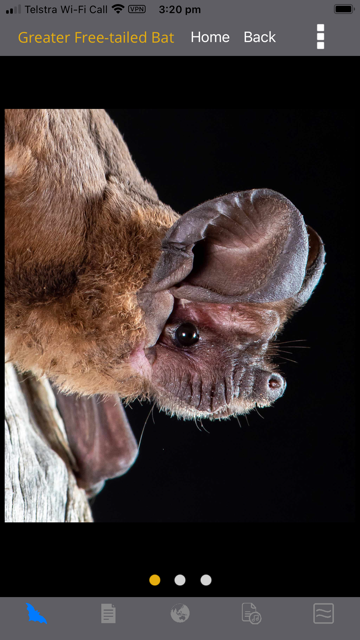

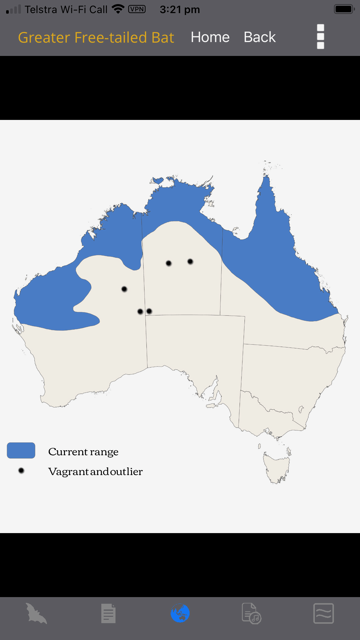
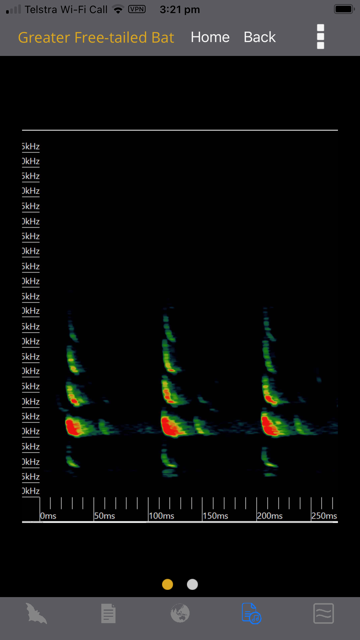
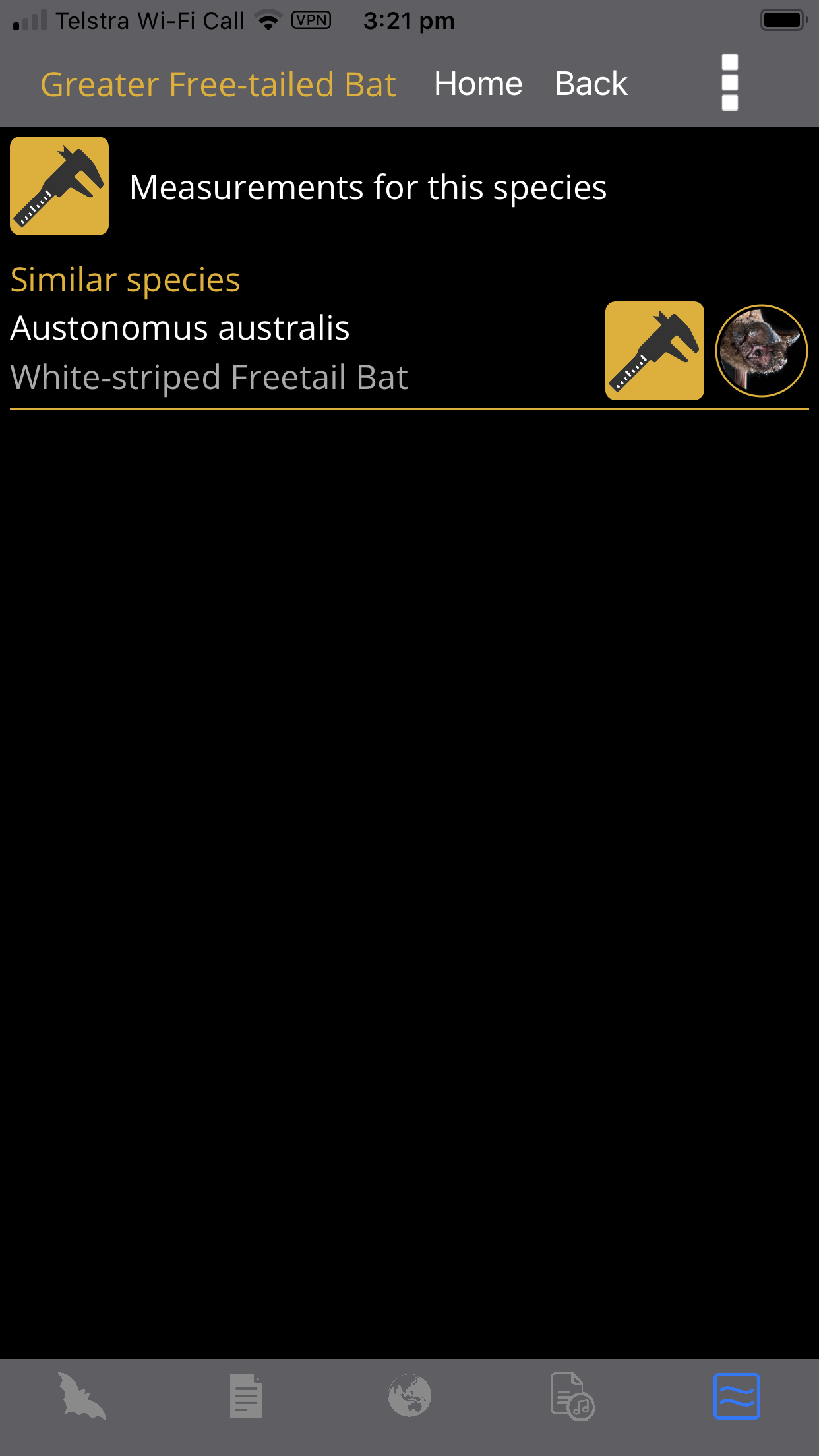
INTERACTIVE IDENTIFICATION KEYS
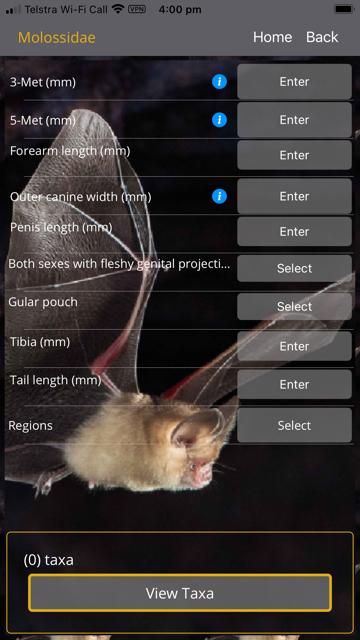
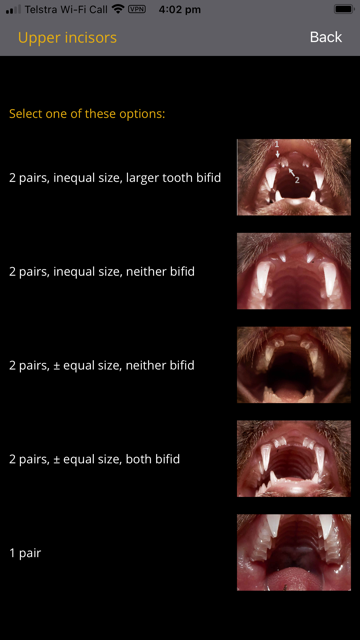
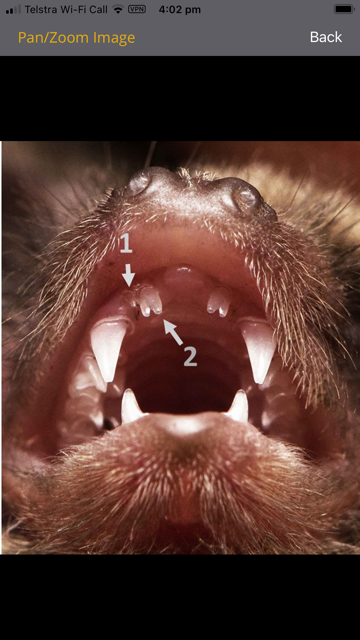
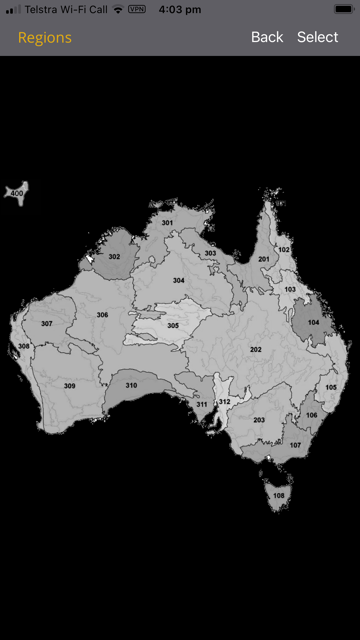
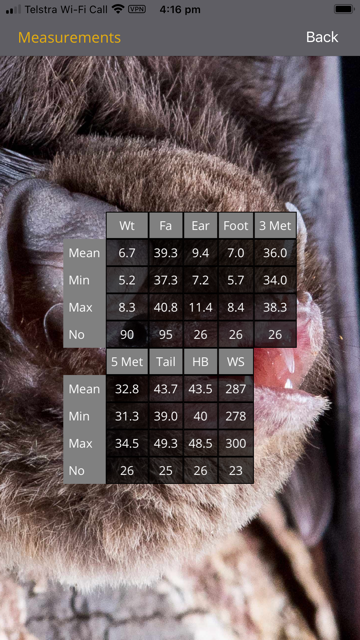
ACKNOWLEDGEMENTS
To say that this project was a collaborative one is a massive understatement. The text has had a long history of development since elements of it first appeared in Sue’s original ‘Australian Bats’ guide. It was then edited and updated for the 2008 guide, and now it has undergone further reviews and been condensed to fit the format of this app. We will, in the future, publish a printed updated field guide.
Many aspects of this app are quite new, including photos, calls, distribution maps and interactive keys. The images, both bats and calls, were produced as a result of many field trips, in particular those from 2018 to the present. During that time, we were helped by so many people that it might take a rare degree of stamina to read through all the names. Without their assistance, this project would never have been possible. From people who helped with field work, gave us somewhere to camp or access to interesting and amazing places, to those who shared their insights into batty behaviour and gave us echo-location call files for rare species, or provided additional images and those who provided advice on the functioning of the app.
So where do we start?
App Development and Design – Heinrich Braasch
Field work – access, accommodation and general field support: Linda and Daryl Paradise; Donna, Clinton, Wyatt and Zack Paradise, Rob and the other Rangers from Pormpuraaw. Tim Hughes from South Endeavour Foundation; Debbie and Rod Randall, and Bill Low, Alice Springs; Lana Little, Chillagoe; Jamie and Michelle Turner, Michael Barritt, Damien Milne, Darwin; Ceinwen Edwards, Ravenshoe; and Jenny Maclean, Tolga Bat Hospital, Atherton Tablelands; Dennis Matthews and Diana Gillatt, Nuriootpa; Trish Wimberley, Advancetown; Scott Suridge and Sandy Toth, Christmas Island; Marie Cali, town; Heather Caufield, town; Norm McKenzie, Perth.
Additional Bat calls – Erin Westerhuis; Greg Ford, Balance! Environmental; Julie Broken-Brow, Elizabeth Williams; Paul Barden; Nicola Hanrahan.
Additional Photos – Angus McNab; Dennis Matthews; Lindy Lumsden.
App Testing and Advice on Design and Function - Elizabeth Williams, Lindsay Agnew, Norm McKenzie.
Distribution Maps are produced by the Australasian Bat Society (ABS) under Creative Commons Attribution 4.0 International license. For more information about the ABS please refer to their website.
© Copyright Text Sue Churchill 2022, Images Bruce Thomson or as otherwise indicated on the images.
IF YOU HAVE ANY COMMENTS OR NEED HELP…..